Contents
Almost every gardener, when creating flower beds with his own hands, is faced with the question of how to make a flower garden a worthy frame. After all, a fence for a flower bed is not just a decorative element of the landscape, but also a structure that carries a functional load. There are many budget, but rather original ways to design flower beds from residual and improvised materials that can turn an ordinary flower arrangement into a designer flower bed.
Why do you need a fence
Of course, the main purpose of the fence is to make the flower arrangement decorative and complete. Fences, harmoniously combined with the overall landscape, emphasize the unity of style on the site, combine all the elements into one. This is an aesthetic side, but besides it, functional tasks are also assigned to the fences:
- protection of plants from poultry, animals, as well as small children – it often happens that children pick off buds, or get hurt on rose thorns;
- protecting the flower bed from weeds – the fence, partially buried in the ground, prevents the penetration of creeping weeds;
- prevention of shedding and spreading of the soil (especially important for flower beds raised above the surface);
- blocking the roots of perennials growing in a flower bed – among perennials there are such plants, for example, ferns, which grow very quickly and crawl out of the flower garden;
- space zoning – decorative fences and hedges are often used to delimit zones on the site, as they allow you to visually combine the space, or vice versa, highlight something.
Video “A selection of options for summer cottages”
Video selection of several options for fences for flower beds.
Kant concrete
This fence is a strip of concrete poured into the ground (like a foundation). Of course, such an edge cannot be called a full-fledged fence, since it only visually limits the edges of the flower garden, but despite this, the concrete edge is the most durable fence and an insurmountable barrier to the roots of perennials or creeping weeds. To build a fence for a flower bed of cement with your own hands is quite simple:
- first you need to lay out the outline of the future fence – you can draw the outlines with loose sand, chalk, but the easiest way to do this is with a garden hose, since it is quite flexible and easily changes shape;
- then, along the contour, a recess (trench) is made in the ground to a depth of 15-20 cm – the width of the trench is arbitrary and depends on the dimensions of the flower garden;
- any synthetic fiber is placed at the bottom of the trench, for example, geotextiles, on top of a layer of sand 5-7 cm, which must be well compacted – such a pillow will serve as protection against deformation and destruction of the foundation by the roots of weeds and perennials;
- then you need to install formwork from boards or pieces of slate (with slate you get a wavy monolithic fence), and pour cement mortar.
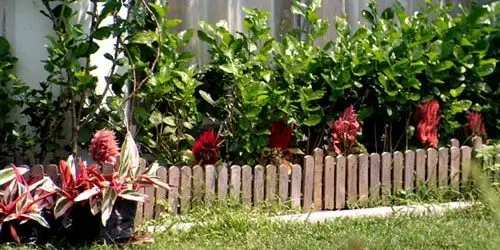
The time for complete drying of the structure is 2-3 days. Alternatively, you can lay decorative pebbles, pebbles, the remains of broken tiles or glass on top of the concrete that has not yet hardened – you get a beautiful mosaic pattern.
Wall block fence
The remains of building concrete blocks can also be used in the garden. Ordinary wall blocks are a very durable material, and those made from rock and shell rocks have a fairly decorative and natural look, so they can organically complement any flower garden.
Blocks are also good because their use is multivariate – you can come up with shapes, change the height, divide one design into several separate containers. To make such a fence with your own hands, you only need blocks and an adhesive mixture. The structure is constructed by analogy with brickwork. You can fasten the blocks together with special glue or ordinary cement mortar. The height of the structure can be very different, but less than two elements up. When the fence dries, soil is poured into the containers, having previously laid a layer of drainage, and plants are planted.
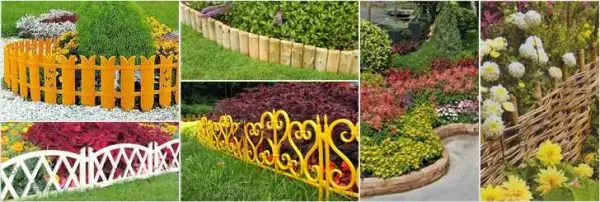
Curb Fence
The border tape is a flexible and fairly light material designed to delimit the lines of landscape elements: flower beds, paths, beds. Now the stores sell roll tape of various colors, structures, lengths and widths. Mounting such a fence with your own hands is very simple and it does not take much time.
To work, you will need tools: a shovel, scissors, tape measure, a construction stapler or liquid nails (for fastening the edges). Further installation of the border is as follows:
- we dig a groove along the contour of the flower garden (the depth of the groove depends on the width of the tape) – for perennial beds it is better to choose a wide tape, and, accordingly, dig a deeper groove;
- then we insert the tape perpendicular to the surface into the prepared trench, fix it, and fill it with soil;
- in conclusion, we tamp the soil well, and the fence can be considered ready.
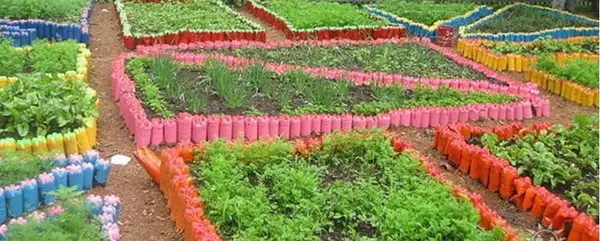
A fence for a flower bed from a tape can have many options. With the help of strips of different widths and colors, you can create interesting multi-tiered compositions, separate the area of u10buXNUMXbgrowth of individual plants. Another advantage of the curb tape is that it can be dismantled at any time and then reused – the service life of this material is more than XNUMX years.
Wattle
A wicker fence is the most colorful and sophisticated design option for a flower garden. Wattle is made from thin and flexible branches, mostly willow. To weave such a fence with your own hands, you need to prepare in advance – cut willow branches and remove the bark from them. It is better to make a blank in the spring, because at this time the rods are very flexible and pliable. Wicker fence is mounted as follows:
- supports (pegs, poles) are installed along the perimeter of the flower bed, to which the wattle fence will be attached – it is better to place the supports at a short distance (20-30 cm), so the wicker fence will be stronger;
- then we braid the rods, pushing them between the supports alternately – you need to start weaving from the outside so that the edges of the branches are not noticeable;
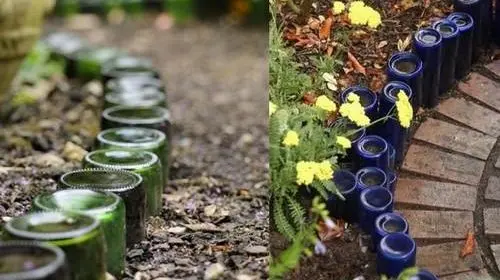
- each wicker row is tapped with a hammer and compacted so that there are no holes in the fence;
- at the end, we nail the ends of the branches with nails to the extreme supports.
That’s all, the original wattle fence for the flower garden is ready. If desired, you can cover the decorative fence with stain or varnish.
slate
Of course, this option is not attractive, but due to the fact that the remains of slate are difficult to adapt for other purposes, many summer residents use it to decorate flower beds. Creating such a masterpiece with your own hands is very simple:
- you need to dig a narrow recess along the contour of the flower garden;
- then drive in small poles or pegs for support – this is not a mandatory measure, since slate itself is a very resistant and hard material;
- then we insert the pieces of slate into the trench, fill it with soil and compact it.
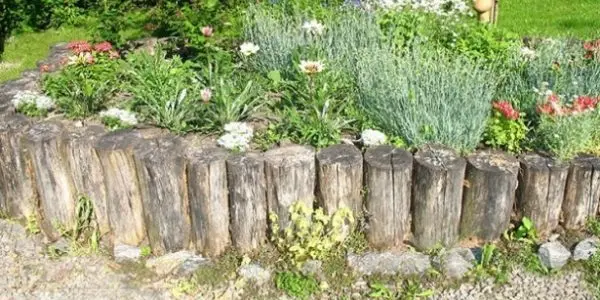
In order to somehow give the fence a decorative look, some summer residents clean it of dust and paint it in a bright color.
Hedge
Decorative hedges, planted with your own hands from living plants, make the flower beds especially lively and natural. It is better to choose garden crops for fencing from perennials that:
- undersized, with a compact, easily formed crown;
- unpretentious to weather, weeds and diseases;
- retain their decorative appearance for a long time – from perennials, evergreen garden shrubs can be used as a hedge;
- have a prominent color – from perennials, burgundy leaves in geyhera, silvery – in cineraria;
- and are able to form a dense coating.
bottle fence
Colored bottles can also make bright decorative flower beds. For the manufacture of the border, you can use both plastic and glass bottles. Moreover, the latter have an advantage, since they are able to withstand strong temperature changes, which cannot be said about plastic. To make a bottle fence with your own hands you need:
- fill the bottles with sand, small pebbles or earth (for strength);
- dig a recess along the contour of the flower garden;
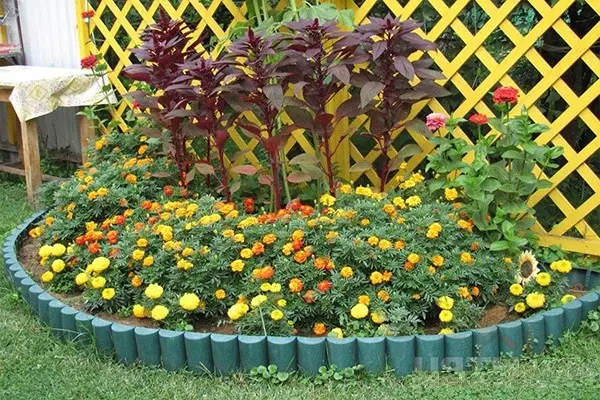
- insert the bottles into the trench with their necks down and sprinkle with earth up to half – to achieve the same height, the protruding bottles are driven into the ground with a hammer.
To give the bottles aesthetics, they are tied with a bright rope, mulched with colored gravel. When using plastic containers, you can cut off the tops and plant small flowers there – you get decorative mini flower beds.
Video “Many options for giving”
Demonstrative video with various options for fences for summer cottages.









